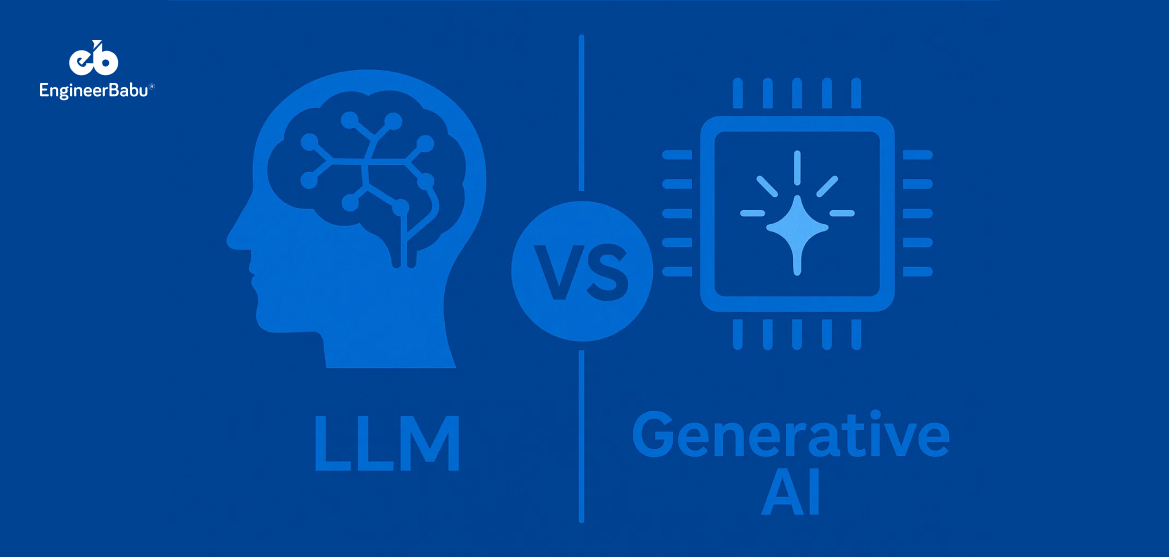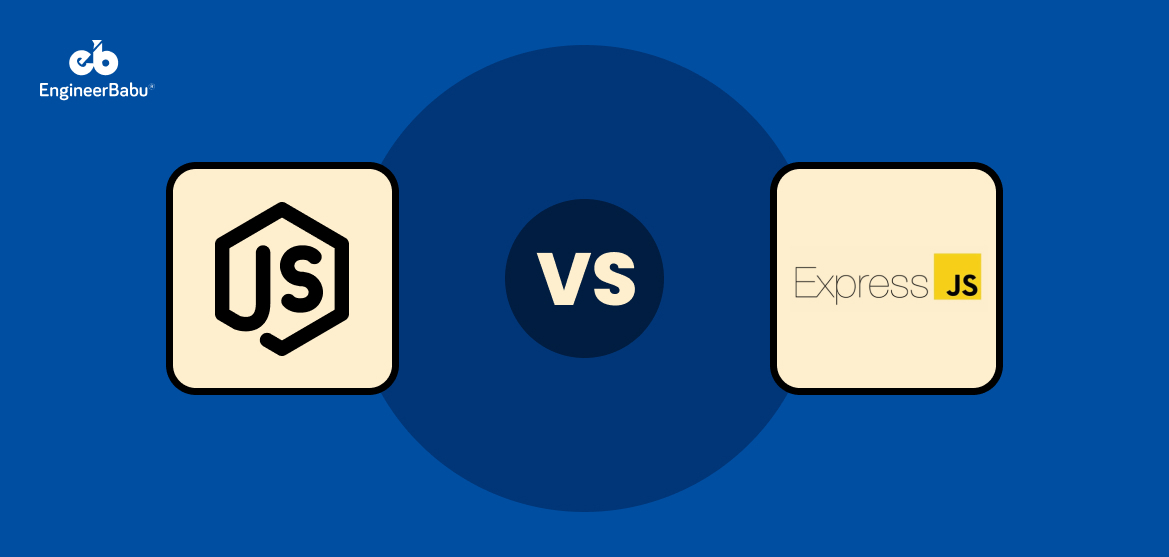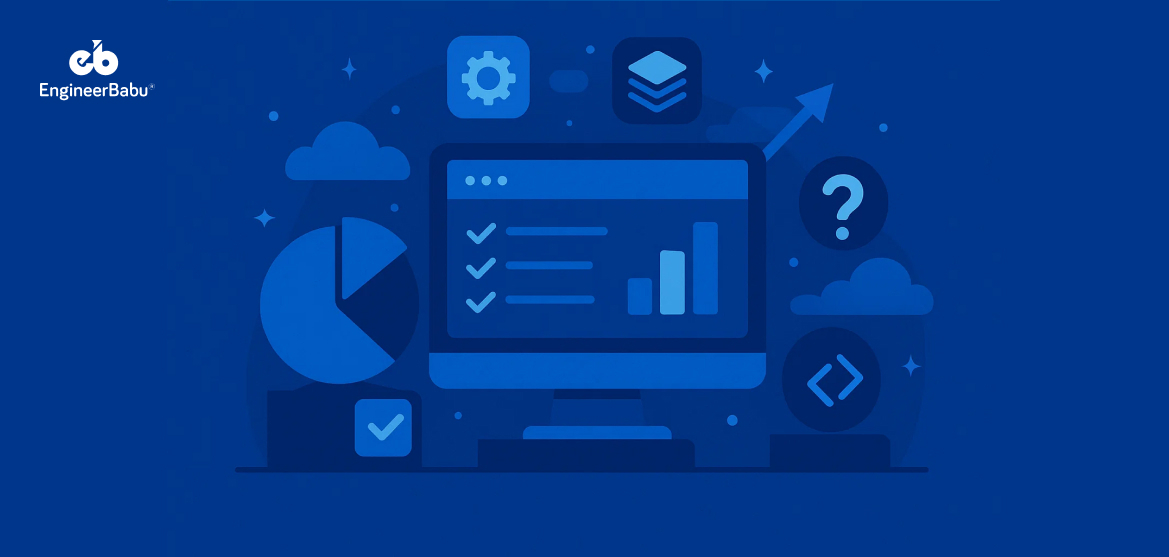When you hear people talk about AI today, chances are you’ll come across two terms almost everywhere: Generative AI and Large Language Models (LLMs). They’re often used interchangeably, which makes things confusing. After all, if ChatGPT is built on an LLM but also called Generative AI, aren’t they the same thing?
Not quite.
The global generative AI market is projected to hit $1.3 trillion by 2032, as per Bloomberg, and much of that growth is being driven by LLMs. But while the two are related, they don’t represent the same technology.
LLMs are a specialised branch of Generative AI designed to understand, process, and produce human language. Generative AI, in contrast, covers a wider spectrum of models that can create entirely new content across formats like text, images, audio, and video.
Therefore, this blog breaks down LLM vs Generative AI in easy language – what each one means, how they’re connected, and where they differ. By the end, you’ll be able to clearly explain the difference without getting lost in the jargon.
What is Generative AI?
Generative AI refers to a broad category of artificial intelligence systems built to create rather than just classify or predict. Instead of only analysing data, these models learn complex patterns from vast datasets and then use that knowledge to generate new content.
The outputs can take many forms, such as natural language, realistic images, audio tracks, video clips, or even working code. This creative capability is what sets Generative AI apart from traditional AI systems, which are usually focused on recognition, detection, or optimization tasks.
Examples:
Text-to-image platforms like DALL·E or MidJourney can produce original artwork from a simple sentence. Music generation tools can compose unique soundtracks in different genres.
Moreover, code-focused models can draft scripts or automate repetitive programming tasks. ChatGPT, too, is considered a product of Generative AI, though it specifically relies on a Large Language Model.
Key Feature:
Its core strength lies in producing novel, context-aware outputs that feel human-made, positioning Generative AI as the foundation for innovations across industries. It’s a key difference in the LLM vs Generative AI discussion.
What are Large Language Models (LLMs)
Large Language Models, or LLMs, are a specialised class of Generative AI designed to understand, process, and generate human language. They are trained on massive volumes of text data, ranging from books and articles to websites, so they can predict the next word in a sequence and build meaningful sentences.
This training enables them to perform a wide variety of language-related tasks, from answering questions and summarising documents to drafting professional emails or creative stories.
Examples:
Well-known LLMs include OpenAI’s GPT-4, Google’s PaLM, Meta’s LLaMA, and Anthropic’s Claude. Each of these is tailored for slightly different use cases, but all excel in tasks where natural language understanding and generation are central.
Key Feature:
LLMs specialise in text. Unlike broader Generative AI models that span images, audio, or video, their strength lies in producing coherent, context-rich written content.
LLM vs Generative AI: The Key Differences
When exploring Generative AI vs LLM, it’s easy to assume they’re interchangeable. Both technologies create new content, but their scope and capabilities are not the same.
To make the difference clearer, let’s look at how they compare across key areas like scope, capabilities, training data, examples, and use cases. This structured view helps explain why the LLM vs Generative AI conversation is about hierarchy, not competition.
Scope
LLMs are built exclusively for language-based tasks such as reading, writing, and reasoning with text. They don’t extend to non-verbal content like images or videos.
Generative AI, on the other hand, is not restricted to words; it spans multiple modalities. It can generate text, produce artwork, compose music, or even simulate voices.
The LLM vs Generative AI difference here is straightforward: LLMs focus narrowly on human language, while Generative AI casts a much wider net across different types of creative output.
Core Capability
LLMs specialise in natural language understanding and generation. Their strength lies in predicting the next word, crafting fluent sentences, and maintaining context within conversations.
Generative AI, by contrast, thrives in multimodal creativity. It can design graphics, compose audio, produce video, and generate code, all by identifying patterns in diverse datasets.
When viewed side by side, LLMs excel in language precision, while Generative AI shines in versatility, offering a richer toolkit for content creation across industries.
Training Data
The training foundation is another area where LLM vs Generative AI diverges. LLMs rely primarily on text-heavy datasets sourced from books, websites, articles, and documents. Thus, giving them a strong command over grammar, semantics, and reasoning in written form.
Generative AI models, however, are trained on a much broader mix of data, including images, audio files, videos, and structured information. This wider training base allows Generative AI systems to create across formats.
In short, LLMs master language, while Generative AI learns from multimodal datasets to fuel broader creative capabilities. This versatility is exactly why demand for generative AI development services is rapidly rising.
Examples
Examples help clarify the LLM vs Generative AI distinction. LLMs include models like GPT-4, Claude, PaLM, and LLaMA, all built to process and generate language-driven responses. They power chatbots, content assistants, and knowledge systems.
Generative AI, however, includes tools such as DALL·E, MidJourney, and Stable Diffusion, which create art or imagery, as well as music generators and video synthesis platforms.
Interestingly, ChatGPT is both, it’s powered by an LLM yet also considered Generative AI. This overlap shows how subsets like LLMs contribute to the broader generative landscape.
Use Cases
In practice, LLM vs Generative AI shows up in different applications. LLMs are widely used in customer support chatbot development, summarising long documents, generating reports, or assisting with translations. They streamline text-driven workflows.
Generative AI, however, is far more expansive, driving applications in creative design, marketing visuals, entertainment, and even synthetic data creation for research.
Together, they serve unique but complementary needs: LLMs excel at making written communication efficient, while Generative AI empowers industries to build innovative experiences across text, visuals, audio, and code.
LLM vs Generative AI: Quick Comparison
| Aspect | Large Language Models (LLMs) | Generative AI |
| Scope | Focused solely on language-based tasks like text generation. | Covers multiple modalities: text, images, audio, video, code. |
| Core Capability | Understand, process, and generate human-like text. | Create original, multimodal outputs across different formats. |
| Training Data | Trained primarily on massive text datasets. | Trained on diverse datasets (text, images, sound, video). |
| Examples | GPT-4, Claude, LLaMA, PaLM. | DALL·E, MidJourney, Stable Diffusion, ChatGPT. |
| Use Cases | Chatbots, summarisation, translation, and content drafting. | Digital art, music composition, video generation, coding assistants. |
How LLMs and Generative AI Work Together
Think of LLMs as the “language brain” inside many Generative AI systems. On their own, LLMs excel at text like writing articles, answering questions, or drafting emails. But when paired with other generative models, the possibilities expand.
For example, an LLM can take your text prompt, understand the context, and then hand it off to an image generator to create a picture that matches the description. The same applies to voice: the LLM writes a script, while a speech model brings it to life.
In practice, this partnership is what makes tools like ChatGPT feel versatile. The LLM handles the reasoning and conversation, while the broader Generative AI ecosystem layers in multimodal features like image generation, code writing, or even video editing.
Instead of thinking of LLM vs Generative AI as rivals, it’s more accurate to see them as teammates, with LLMs providing structure and meaning, and Generative AI delivering creativity across different formats.
Conclusion
The debate around LLM vs Generative AI often creates more confusion than clarity, but the difference is straightforward once you break it down. LLMs are specialists in language, they understand, process, and generate text with fluency.
Generative AI, on the other hand, is the broader umbrella capable of creating content across multiple formats, from images to audio to code. Together, they form the backbone of today’s most innovative tools, powering both productivity and creativity.
If your business is exploring how to leverage these technologies, it’s the right time to bring in experts who can design tailored solutions. As a leading software development company, we help brands unlock the potential of advanced AI systems.
Hire generative AI developers with us to bring your ideas to life.
FAQs about Generative AI vs LLM
Are all Large Language Models a type of Generative AI?
Yes. LLMs are a subset of Generative AI, focused specifically on text-based tasks like writing, summarising, and translating, while broader Generative AI covers multiple formats such as images, audio, and video.
What makes Generative AI different from traditional AI?
Traditional AI analyzes data to predict or classify, while Generative AI creates new content like text, images, or music. The key difference is creativity, Generative AI produces original outputs, not just insights or recommendations.
Can LLMs generate images or audio?
No. LLMs work only with text. To generate images or audio, they need to be paired with other Generative AI models that specialise in those content formats.
Which industries benefit most from Generative AI?
Marketing, healthcare, education, design, and entertainment see the biggest gains. Generative AI helps with automation, personalisation, content creation, and innovation across these industries, making workflows more efficient and impactful.
Why should businesses invest in Generative AI now?
Generative AI adoption is growing rapidly. Early investment helps businesses gain a competitive advantage, improve efficiency, lower costs, and deliver personalised experiences to customers before the technology becomes fully mainstream.




